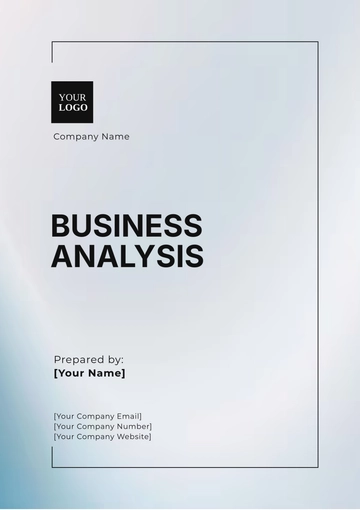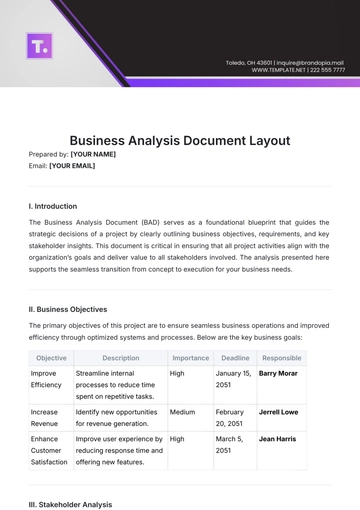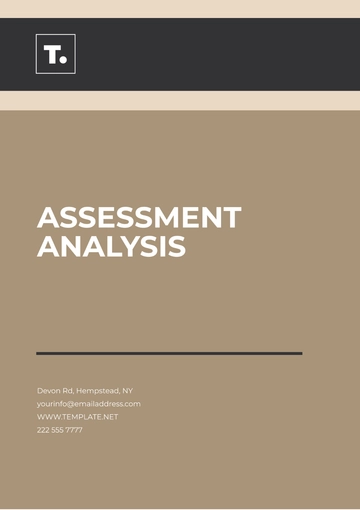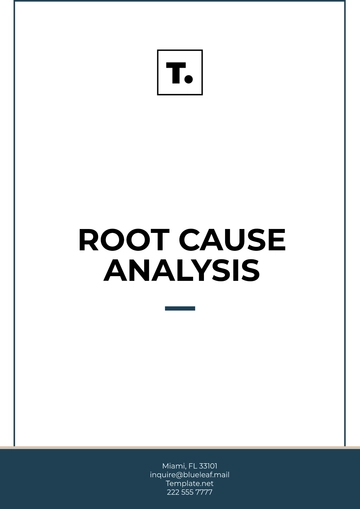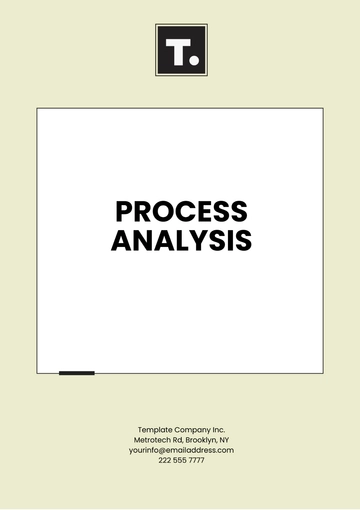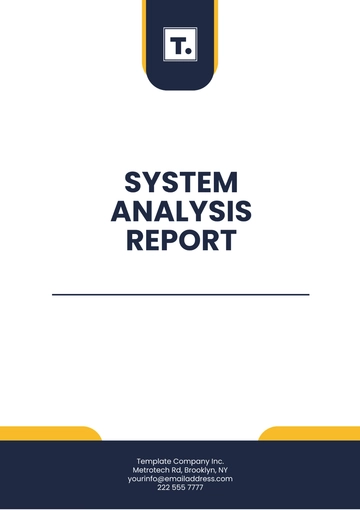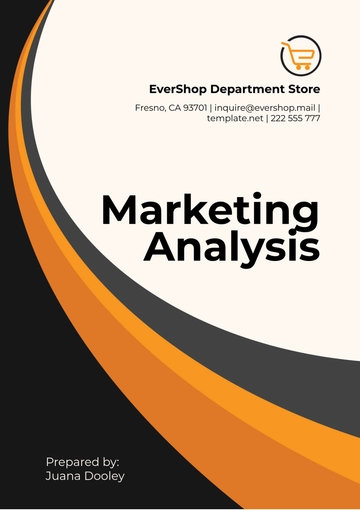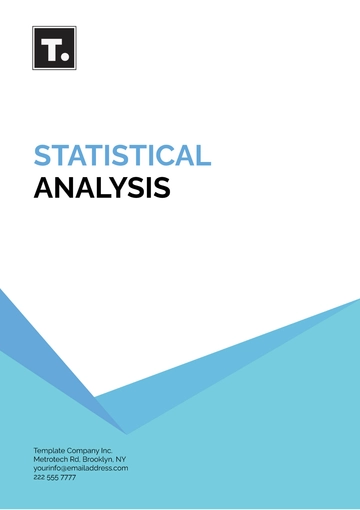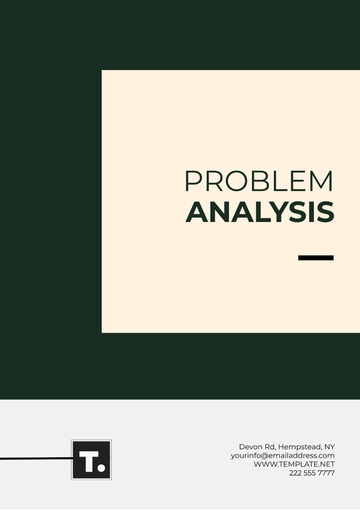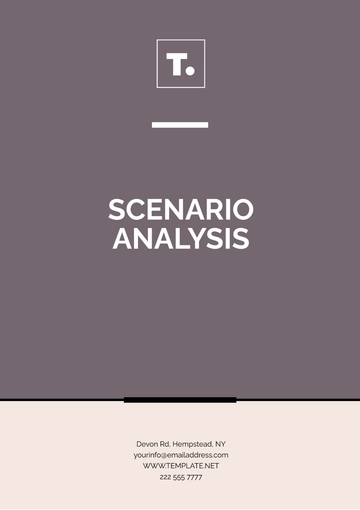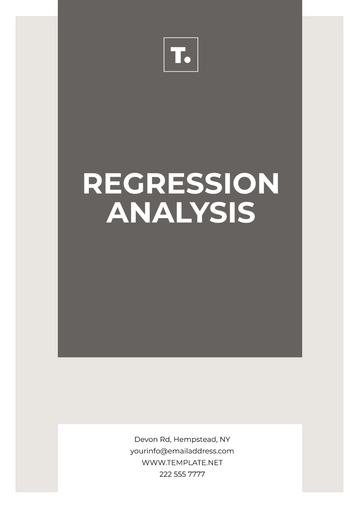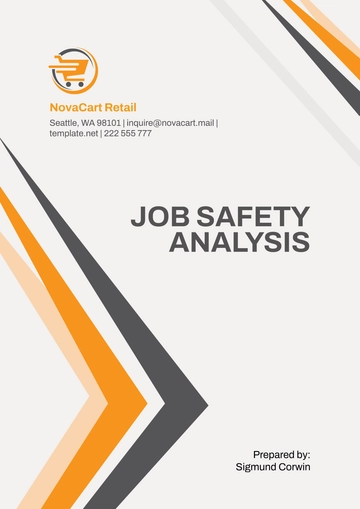Free Sales Presentation Audience Analysis

1. Introduction to the Audience
In our pursuit of establishing a solid foundation for effective communication and engagement, it is imperative to recognize the significance of understanding our audience – the [Prospective Client Corporation]. This introductory segment serves as the compass, guiding us through the intricate terrain of audience analysis. It is an indispensable step in our quest to tailor our sales presentation strategy, aligning it with the distinct needs and preferences of our prospective clients. To embark on this journey, we must first define the purpose, identify key stakeholders, gather demographic information, and grasp the audience's role in the decision-making process.
A. Define the purpose of the audience analysis
Our overarching objective is to delve deep into the intricacies of the [Prospective Client Corporation], discovering insights that will not only facilitate a comprehensive understanding of their operations but also enable us to customize our sales presentation strategy with precision. In doing so, we aspire to enhance our chances of success by aligning our proposal with their specific requirements.
B. Identify the key stakeholders and decision-makers
Within [Prospective Client Corporation], the decision makers are individuals of great influence. It is imperative that we recognize and acknowledge the power players in this field. The key stakeholders we need to engage with include the esteemed CEO, the visionary CMO, and the discerning Head of Procurement. Furthermore, our success hinges upon the approval of our proposal by [Name1] and [Name2], who wield considerable influence in shaping the destiny of our partnership.
C. Gather basic demographic information
To form a holistic understanding of [Prospective Client Corporation], we must examine the demographic landscape. Situated in the vibrant city of [City], [Country], our prospective client boasts a diverse workforce of approximately [3000] employees. This mosaic comprises individuals spanning a wide range of age groups, primarily [male/female], and hailing from various regions, notably [location]. Armed with this demographic data, we can better contextualize our approach and refine our messaging.
D. Understand the audience's role in the decision-making process
Understanding the role [Prospective Client Corporation] plays in the decision-making process is paramount. They stand as the gatekeepers to our success, holding the authority to either greenlight our proposal or send it to the abyss of rejection. Their overarching objective is the enhancement of [specific business process], driven by a relentless pursuit of cost savings and operational efficiency. This insight underscores the gravity of our task, as we strive to craft a proposal that aligns seamlessly with their aspirations.
As we journey through this audience analysis, armed with purpose and knowledge, we will navigate the intricacies of our prospective client's world. By the journey's end, we will possess the insights required to tailor our sales presentation strategy to perfection, setting the stage for a prosperous partnership.
2. Psychographic Analysis
Understanding our audience, the [Prospective Client Corporation], is paramount to crafting a sales presentation strategy that resonates with their values and aspirations. This section delves into their interests, values, beliefs, pain points, needs, desires, familiarity with our product, and potential objections.
A. Explore the audience's interests, values, and beliefs
To truly connect with our prospective client, we must first step into their world. [Prospective Client Corporation] places a premium on innovation and sustainability. They are ardent proponents of adopting modern solutions that not only reduce their environmental footprint but also enhance operational efficiency. This commitment to sustainable progress serves as a guiding star, illuminating the path we must tread as we seek to align our proposal with their core values.
Aspect | Description |
|---|---|
Interests | Innovation, technology advancements, and sustainable practices. |
Values | Sustainability, efficiency in operations, and corporate responsibility. |
Beliefs | Modern solutions can and should be environmentally friendly and operationally efficient. |
B. Determine their pain points, needs, and desires
We uncover a pressing pain point: the inefficiency plaguing their current [process]. It is a thorn in their side, impeding progress and causing unnecessary resource drains. Their deepest desire is a solution capable of streamlining this [process], all while ensuring a delicate balance between cost reduction and environmental stewardship. Recognizing these critical elements empowers us to tailor our proposal as a beacon of hope, promising to address these pain points and fulfill their desires.
Pain Point | Needs | Desires |
|---|---|---|
Inefficiency in [process] | Streamlined, efficient solutions | A balance between cost reduction and environmental care. |
C. Assess their level of familiarity with your product or service
In our previous encounters with [Prospective Client Corporation], we initiated a journey of familiarity. They have glimpsed the potential of our product through a demonstration during a prior meeting. However, we stand at the threshold of deeper engagement, as they require a more profound understanding of our offering to make an informed decision. Thus, our task is to provide them with the knowledge and insights they need to appreciate the transformative power of our solution fully.
Previous Engagement | Current Familiarity Level | Required Action |
|---|---|---|
Demonstrated in prior meeting | Moderate | Deeper engagement and detailed explanation of benefits. |
D. Identify any challenges or objections they may have
Navigating the complexities of the sales process often brings forth challenges and objections. For [Prospective Client Corporation], these may include apprehensions about potential implementation disruptions and the initial investment required to embark on this transformative journey. Addressing these concerns with clarity and confidence is imperative. It not only demonstrates our preparedness but also showcases our commitment to forging a partnership grounded in trust and mutual benefit.
Potential Challenges | Potential Objections | Strategy to Address |
|---|---|---|
Implementation disruptions | Concerns about the transition period | Highlighting ease of integration and support structures. |
Initial investment concerns | Questions about cost-effectiveness and ROI | Providing clear ROI calculations and long-term benefits. |
As we traverse the field of analysis, we equip ourselves with the knowledge required to engage the [Prospective Client Corporation] on a profound level. Armed with insights into their values, pain points, desires, familiarity, and potential objections, we are better positioned to craft a sales presentation strategy that resonates, persuades, and ultimately paves the way for a fruitful partnership.
3. Communication Preferences
The steps we take must be guided by an understanding of our audience's preferences. This section delves into the communication preferences of the discerning [Prospective Client Corporation], shedding light on how they prefer to receive information, their communication style, favored channels of communication, and their level of technical expertise.
A. Analyze how the audience prefers to receive information
In the field of information consumption, [Prospective Client Corporation] exhibits a discerning palate. They harbor a preference for detailed presentations and written materials that provide a comprehensive view of the subject matter. These serve as their compass, guiding them through the labyrinth of complex ideas. Additionally, face-to-face interactions hold a special place in their communication hierarchy, offering the opportunity for in-depth discussions. In the digital realm, email and webinars find favor, providing them with a structured format to digest information at their own pace.
Information Type | Preferred Formats | Notes |
|---|---|---|
General | Detailed presentations, written materials | Prefer comprehensive overviews for informed decision-making. |
Interactions | Face-to-face meetings, Email, Webinars | Value in-depth discussions and structured digital formats. |
B. Consider their preferred communication style
The nuances of communication style are not lost on [Prospective Client Corporation]. During official meetings, formality reigns supreme, reflecting their commitment to professionalism and respect for protocol. However, this veneer of formality undergoes a transformation during networking events and social gatherings, where a more informal and approachable demeanor prevails. Recognizing and adapting to these shifts in style is essential to forging authentic connections.
Setting | Style | Notes |
|---|---|---|
Official Meetings | Formal | Demonstrates professionalism and respect for protocol. |
Networking/ Social Gatherings | Informal | Favors approachability and genuine connections. |
C. Determine their preferred channels of communication
In the ever-expanding landscape of communication channels, it is imperative to navigate with precision. For [Prospective Client Corporation], LinkedIn stands tall as the bastion of professional interaction, where connections are forged and insights are shared. Email serves as the official corridor for correspondence, maintaining a structured and organized flow of information. However, when depth and detail are paramount, face-to-face meetings reign supreme, offering an environment conducive to robust discussions and relationship-building.
Channel | Usage | Notes |
|---|---|---|
Professional networking | Key platform for forging connections and sharing insights. | |
Official correspondence | Preferred for structured, formal communication. | |
Face-to-Face | In-depth discussions, relationship-building | Valued for comprehensive communication and rapport building. |
D. Understand their level of technical expertise
Within [Prospective Client Corporation], we encounter a spectrum of technical expertise. Some individuals display an innate savviness with technology, effortlessly navigating the digital realm. Others adhere to more traditional approaches, valuing tried-and-true methods. Recognizing this diversity is essential, as it informs the manner in which we present information, ensuring that it resonates with the audience regardless of their technical acumen.
Audience Segment | Expertise Level | Notes |
|---|---|---|
Tech-Savvy Individuals | High | Comfortable with digital platforms and innovative solutions. |
Traditional Users | Moderate to Low | Prefer straightforward, proven communication methods. |
The field of communication preferences is a multifaceted landscape, and our mastery of it is essential to foster meaningful connections with the [Prospective Client Corporation]. Armed with insights into their information consumption habits, communication style, favored channels, and technical expertise, we are poised to engage with precision and finesse, thereby strengthening our prospects for a successful partnership.
4. Competitive Analysis
In the field of business, the landscape is rarely devoid of competition, and understanding how our prospective client perceives and engages with competitors is crucial. This section delves into the competitive analysis of the discerning [Prospective Client Corporation], exploring their current alternatives or competitors, perceptions of competitor strengths and weaknesses, factors influencing their decision-making, and any past interactions or experiences with competitors.
Competitive Analysis Matrix
Competitor | Strengths | Weaknesses |
Competitor A | High-quality materials Established reputation Excellent customer support | Limited customization Higher pricing Longer delivery times |
Competitor B | Competitive Pricing Quick delivery times Robust online presence | Limited product range Less established reputation Limited customer support |
Competitor C | Customizable solutions Innovative technology Strong track record | Comprehensive support Competitive Pricing Quick delivery times |
A. Evaluate the audience's current alternatives or competitors
Navigating options, [Prospective Client Corporation] stands at the threshold of a decision, with [Competitor A] and [Competitor B] beckoning as viable alternatives to our solution. It is within this crucible of alternatives that we must prove our mettle and demonstrate our superiority.
B. Identify their perceptions of your competitor's strengths and weaknesses
On their end, [Competitor A] shines in the radiance of a specific feature, one that resonates deeply with their needs and aspirations. Conversely, [Competitor B] wields an advantage in another facet of the competition. However, it is worth noting that both alternatives bear the weight of a common concern – a shared weakness that looms ominously on the horizon. It is within the shadow of this weakness that we find our opportunity to excel.
C. Determine what factors influence their decision-making process
The scales of decision at [Prospective Client Corporation] are not tipped lightly. Factors of significance weigh upon them, driving the course of their deliberations. Among these pivotal factors are the siren calls of cost-effectiveness, the weighty matter of environmental impact, the ease with which implementation can be achieved, and the promise of steadfast long-term support. As we navigate this landscape, it is our duty to address each factor with precision and assurance.
D. Discover any past interactions or experiences with competitors
In the past interactions, [Prospective Client Corporation] has had limited dalliances with competitors. These interactions have predominantly taken the form of introductory meetings and the careful scrutiny of proposals. It is within these encounters that impressions were formed, and expectations were set. We must glean insights from these past experiences to inform our approach and tailor our proposal to meet and exceed their expectations.
Timeline of Past Interactions/Experiences with Competitors
Date | Interaction/Event | Details |
[Month Year] | Initial Meeting | Introduction to Competitor A |
[Month Year] | Proposal Review | Reviewed Competitor A's proposal |
[Month Year] | Networking Event | Informal interaction with Competitor B |
[Month Year] | Detailed Presentation | In-depth discussion with Competitor B |
[Month Year] | Follow-up Meeting | Clarification on Competitor A's proposal |
[Month Year] | Site Visit | Visited Competitor B's facility |
[Month Year] | Decision Deadline | Expected decision date |
As we traverse the field of competitive analysis, we must be armed with knowledge and insight. By understanding the alternatives, perceptions, influencing factors, and past interactions, we are better prepared to navigate the competitive waters. This knowledge empowers us to craft a compelling proposal, one that not only stands tall amidst the competition but also resonates deeply with the discerning [Prospective Client Corporation], thereby strengthening our prospects for success.
5. Tailoring the Presentation
In the field of persuasive communication, the art of tailoring is similar to crafting a bespoke suit, perfectly fitting our audience's needs and aspirations. This section is dedicated to improving our approach in customizing the presentation for the discerning [Prospective Client Corporation], encompassing the development of a tailored message and value proposition, creation of customized content, selection of appropriate visuals and examples, and the delineation of a clear call to action.
A. Develop a tailored message and value proposition
Our presentation serves as a tool for our engagement with [Prospective Client Corporation]. To resonate deeply, it must speak directly to their concerns. Therefore, our focus will be on showcasing how our solution acts as a panacea for their specific pain points. We will emphasize its transformative potential in streamlining [specific pain points] while underscoring our unwavering commitment to sustainability and the promise of cost savings. This message shall serve as the North Star, guiding our audience toward the path of alignment.
B. Create customized content
Generic content has no place in our presentation. We shall weave a tapestry of customizations, tailoring our narrative to the unique needs and aspirations of [Prospective Client Corporation]. Case studies will take center stage, offering tangible proof of successful implementations within similar industries, and instilling confidence in the transformative power of our solution. Additionally, a comprehensive ROI analysis will offer a clear and compelling rationale for their investment.
C. Select appropriate visuals and examples
A picture is worth a thousand words, and in the field of persuasion, visuals wield immense power. Infographics will take their place within our presentation, illustrating the efficiency gains and environmental benefits that our solution delivers. Real-world examples, drawn from our extensive portfolio, will breathe life into our message, allowing [Prospective Client Corporation] to see themselves in the narrative, resonating with the challenges they face.
D. Outline a clear call to action
Our presentation is not a one-sided monologue; it is an invitation to engage in a transformative journey. Therefore, it is essential to outline a clear and compelling call to action. We shall encourage [Prospective Client Corporation] to take the next step by scheduling a follow-up meeting. This meeting will be tailored to their specific needs, offering a detailed product demonstration that showcases precisely how our solution can be the catalyst for their success.
The process of tailoring our presentation for [Prospective Client Corporation] is an artful endeavor, one that requires precision, customization, and an unwavering commitment to meeting their unique needs. Armed with a message that resonates, customized content that inspires, visuals that captivate, and a clear call to action that beckons, we are poised to not only engage but to enthrall and compel. This approach ensures that our presentation is not just heard but felt, setting the stage for a mutually beneficial partnership.
6. Conclusion
The process of creating effective sales presentations is highly dependent on understanding the audience. A tailored, clear, and engaging presentation, matched with an audience's unique attributes, can significantly improve the outcomes of any sales presentation. With the insights gathered from this Sales Presentation Audience Analysis, it is clear that relevance, clarity, and engagement play vital roles in sales presentations. By adopting these strategies, professionals can successfully meet their sales objectives and enhance their brand identity.
- 100% Customizable, free editor
- Access 1 Million+ Templates, photo’s & graphics
- Download or share as a template
- Click and replace photos, graphics, text, backgrounds
- Resize, crop, AI write & more
- Access advanced editor
Boost your marketing with Template.net's Sales Presentation Audience Analysis Template. This editable and customizable template, conveniently editable in our AI Editor Tool, streamlines your presentation process. Experience efficiency and precision like never before. Gain superior insights into your audience and increase potential conversions. Stake your claim to success with our professionally designed template.



